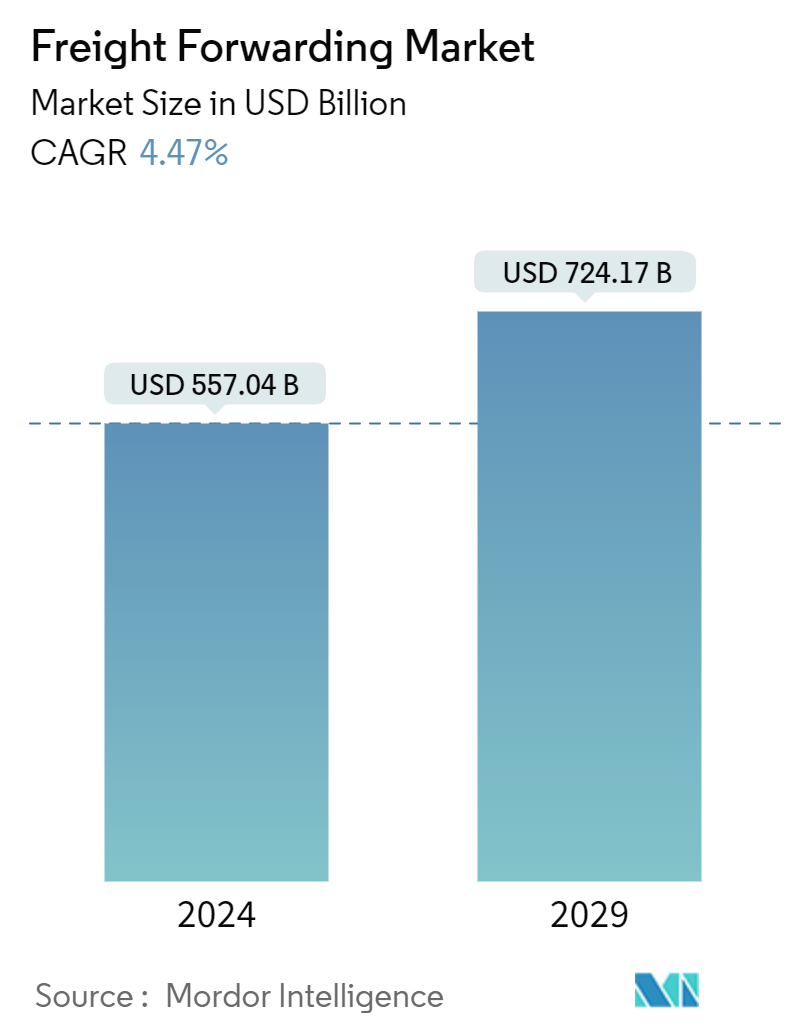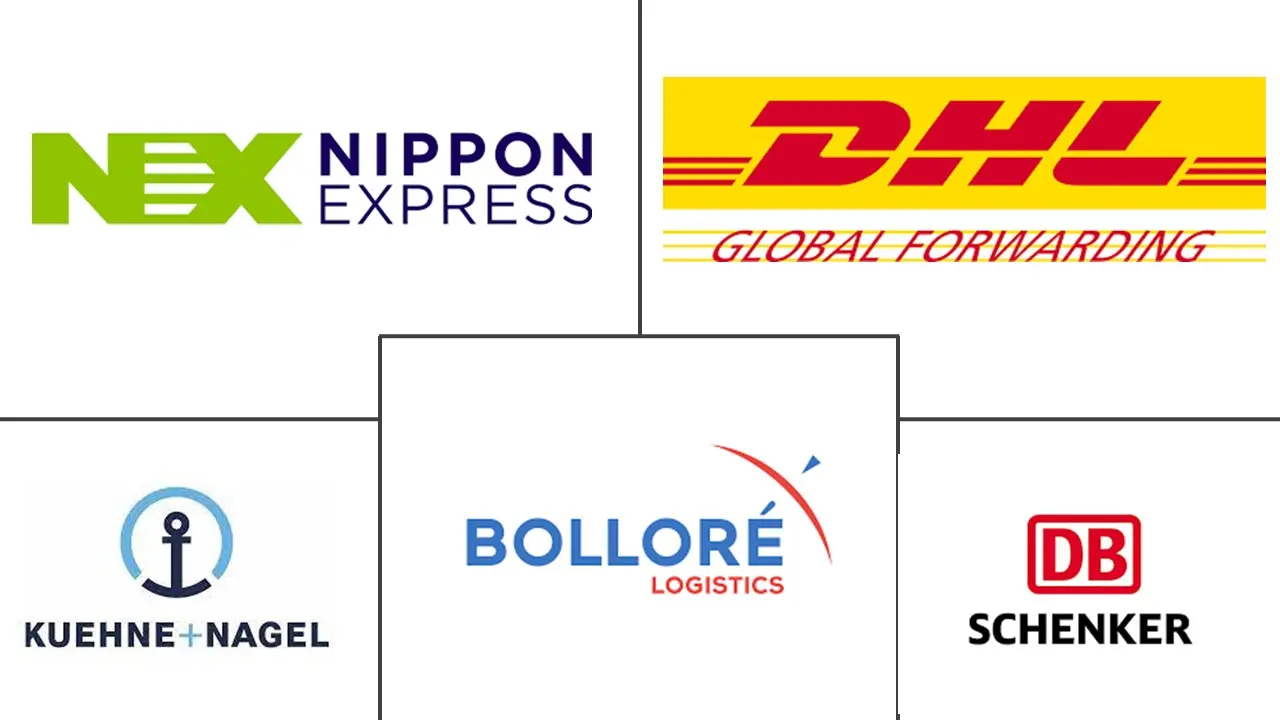Market Size of Freight Forwarding Industry

| Study Period | 2020 - 2029 |
| Market Size (2024) | USD 557.04 Billion |
| Market Size (2029) | USD 724.17 Billion |
| CAGR (2024 - 2029) | 4.47 % |
| Fastest Growing Market | Asia Pacific |
| Largest Market | North America |
| Market Concentration | Low |
Major Players
*Disclaimer: Major Players sorted in no particular order |
Freight Forwarding Industry Analysis
The Freight Forwarding Market size is estimated at USD 557.04 billion in 2024, and is expected to reach USD 724.17 billion by 2029, at a CAGR of 4.47% during the forecast period (2024-2029).
The prompt adoption of technologies such as AI, blockchain, and cloud computing presents a challenge to the freight forwarding industry. The need to invest in these technologies for efficient operation is growing. In September 2023, Uber Freight announced a complete evolution in logistics technologies to power the international movement of goods. With freight worth USD 18 billion, Uber is launching a new generation of products that invest in its advanced technology development abilities and AI-powered software.
In addition to the resumption of freighter schedules, more airline passenger capacity is returning to the market. In 2023, international air travel returned to the pre-pandemic level. The rate remains high but still shallow compared to before the pandemic. Global supply chains persist in being disrupted by trade restrictions involving China, the United States, Russia, Ukraine, and Europe. Suppliers seek other locations to source from outside China, Southeast Asia, and South Asia.
According to freight forwarding industry experts, the ocean forwarding market is evolving faster than expected. The transition from a supply chain struggling to keep up with unprecedented pandemic demand to a weak demand environment is now oversupplied with ships and containers, highlighting the risk of a prolonged global economic downturn. The role of governments is also to facilitate sea routes. As of March 2023, India and Russia considered using the Northern Sea Route, which spans the Arctic, for shipping.
Freight Forwarding Industry Segmentation
Freight forwarding refers to the coordination and transport of goods from one place to another using one or more carriers by air, sea, rail, or road. The principles of freight forwarding focus on the cost-effective and efficient transfer of goods that are always kept in reasonable condition during transport.
A complete freight forwarding industry analysis, comprising the assessment of the economy and contribution of sectors in the economy, freight forwarding industry overview, market size estimation for key segments, and emerging trends in the market segments, market dynamics, freight forwarder market share, geographical trends, and the COVID-19 impact is included in the report.
The freight forwarding market is segmented by mode of transport (air freight forwarding, ocean freight forwarding, road freight forwarding, rail freight forwarding), customer type (B2C and B2B), application (industrial and manufacturing, retail, healthcare, oil and gas, food and beverages, and other applications), and geography (North America, Europe, Asia-Pacific, and LAMEA). The report offers freight forwarding market size, forecasts and freight forwarder market share for all the above-mentioned segments in value (USD).
| By Mode Of Transport | |
| Air Freight Forwarding | |
| Ocean Freight Forwarding | |
| Road Freight Forwarding | |
| Rail Freight Forwarding |
| By Customer Type | |
| B2B | |
| B2C |
| By Application | |
| Industrial And Manufacturing | |
| Retail | |
| Healthcare | |
| Oil And Gas | |
| Food And Beverages | |
| Other Applications |
| By Geography | |||||||
| |||||||
| |||||||
| |||||||
|
Freight Forwarding Market Size Summary
The freight forwarding industry is experiencing a transformative phase, driven by the integration of advanced technologies such as AI, blockchain, and cloud computing. This technological shift is essential for enhancing operational efficiency and meeting the evolving demands of global trade. The industry is witnessing a resurgence in air travel and increased seaborne transport, which are pivotal in facilitating cross-border trade. However, global supply chains continue to face challenges due to geopolitical tensions and trade restrictions, prompting suppliers to explore alternative sourcing locations. The market is characterized by a mix of global giants and regional players, with the top companies holding a significant share. The focus on digital transformation and operational scalability is crucial as the industry navigates through a landscape marked by both opportunities and challenges.
The market size of the freight forwarding industry is poised for growth, supported by the increasing demand for efficient logistics solutions and the expansion of trade networks. Significant investments in infrastructure, such as the development of logistics and trade centers, are underway to accommodate the growing volume of goods transported globally. The air freight segment, in particular, is gaining traction due to its efficiency in handling time-sensitive consignments. Strategic acquisitions and partnerships are enhancing connectivity and service offerings, particularly in regions like ASEAN, which are becoming attractive to international investors. The industry's growth trajectory is further bolstered by the expansion of facilities and services that cater to the diverse needs of global trade, underscoring the importance of adaptability and innovation in maintaining competitive advantage.
Freight Forwarding Market Size - Table of Contents
-
1. MARKET INSIGHTS
-
1.1 Market Overview
-
1.2 Industry Policies and Regulations
-
1.3 Technology Snapshot and Digital Trends
-
1.4 Insights on Technological Advancements in Freight Forwarding
-
1.5 Value Chain / Supply Chain Analysis
-
1.6 Digitalisation of Freight Forwarding Market
-
1.7 Pricing Analysis and Revenue analysis of Freight Forwarding Market
-
1.8 Regional Insights on Freight Forwarding Market
-
1.9 Impact of COVID-19 on the Market
-
-
2. MARKET SEGMENTATION
-
2.1 By Mode Of Transport
-
2.1.1 Air Freight Forwarding
-
2.1.2 Ocean Freight Forwarding
-
2.1.3 Road Freight Forwarding
-
2.1.4 Rail Freight Forwarding
-
-
2.2 By Customer Type
-
2.2.1 B2B
-
2.2.2 B2C
-
-
2.3 By Application
-
2.3.1 Industrial And Manufacturing
-
2.3.2 Retail
-
2.3.3 Healthcare
-
2.3.4 Oil And Gas
-
2.3.5 Food And Beverages
-
2.3.6 Other Applications
-
-
2.4 By Geography
-
2.4.1 North America
-
2.4.1.1 United States
-
2.4.1.2 Canada
-
2.4.1.3 Mexico
-
-
2.4.2 Europe
-
2.4.2.1 Germany
-
2.4.2.2 France
-
2.4.2.3 United Kingdom
-
2.4.2.4 Rest of Europe
-
-
2.4.3 Asia-Pacific
-
2.4.3.1 China
-
2.4.3.2 Japan
-
2.4.3.3 South Korea
-
2.4.3.4 India
-
2.4.3.5 Rest of Asia-Pacific
-
-
2.4.4 LAMEA
-
2.4.4.1 Brazil
-
2.4.4.2 South Africa
-
2.4.4.3 GCC
-
2.4.4.4 Rest of LAMEA
-
-
-
Freight Forwarding Market Size FAQs
How big is the Freight Forwarding Market?
The Freight Forwarding Market size is expected to reach USD 557.04 billion in 2024 and grow at a CAGR of 4.47% to reach USD 724.17 billion by 2029.
What is the current Freight Forwarding Market size?
In 2024, the Freight Forwarding Market size is expected to reach USD 557.04 billion.

